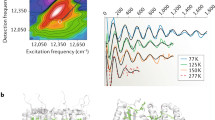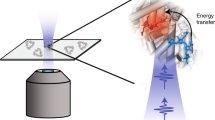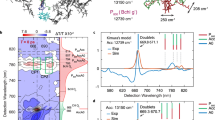Abstract
Absorption of sunlight is the first step in photosynthesis, which provides energy for the vast majority of organisms on Earth. The primary processes of photosynthesis have been studied extensively in isolated light-harvesting complexes and reaction centres, however, to understand fully the way in which organisms capture light it is crucial to also reveal the functional relationships between the individual complexes. Here we report the use of two-dimensional electronic spectroscopy to track directly the excitation-energy flow through the entire photosynthetic system of green sulfur bacteria. We unravel the functional organization of individual complexes in the photosynthetic unit and show that, whereas energy is transferred within subunits on a timescale of subpicoseconds to a few picoseconds, across the complexes the energy flows at a timescale of tens of picoseconds. Thus, we demonstrate that the bottleneck of energy transfer is between the constituents.
This is a preview of subscription content, access via your institution
Access options
Subscribe to this journal
Receive 12 print issues and online access
$259.00 per year
only $21.58 per issue
Buy this article
- Purchase on Springer Link
- Instant access to full article PDF
Prices may be subject to local taxes which are calculated during checkout





Similar content being viewed by others
References
Overmann, J., Cypionka, H. & Pfennig, N. An extremely low-light-adapted phototrophic sulfur bacterium from the Black Sea. Limnol. Oceanogr. 37, 150–155 (1992).
Beatty, J. T. et al. An obligately photosynthetic bacterial anaerobe from a deep-sea hydrothermal vent. Proc. Natl Acad. Sci. USA 102, 9306–9310 (2005).
Pšenčík, J., Butcher, S. & Tuma, R. in Structural Basis of Biological Energy Generation (ed. Hohmann-Marriott, M. F.) 77–109 (Advances in Photosynthesis and Respiration 39, Springer Netherlands, 2014).
Hauska, G., Schoedl, T., Remigy, H. & Tsiotis, G. The reaction center of green sulfur bacteria. Biochim. Biophys. Acta 1507, 260–277 (2001).
Wen, J., Zhang, H., Gross, M. L. & Blankenship, R. E. Membrane orientation of the FMO antenna protein from Chlorobaculum tepidum as determined by mass spectrometry-based footprinting. Proc. Natl Acad. Sci. USA 106, 6134–6139 (2009).
Bína, D., Gardian, Z., Vácha, F. & Litvín, R. Native FMO-reaction center supercomplex in green sulfur bacteria: an electron microscopy study. Photosynth. Res. 128, 93–102 (2016).
Milder, M. T. W., Brüggemann, B., van Grondelle, R. & Herek, J. L. Revisiting the optical properties of the FMO protein. Photosynth. Res. 104, 257–274 (2010).
Mimuro, M. et al. Excitation energy flow in chlorosome antennas of green photosynthetic bacteria. J. Phys. Chem. 93, 7503–7509 (1989).
Müller, M. G., Griebenow, K. & Holzwarth, A. R. Picosecond energy transfer and trapping kinetics in living cells of the green bacterium Chloroflexus aurantiacus. Biochim. Biophys. Acta 1144, 161–169 (1993).
Causgrove, T. P., Brune, D. C., Wang, J., Wittmershaus, B. P. & Blankenship, R. E. Energy transfer kinetics in whole cells and isolated chlorosomes of green photosynthetic bacteria. Photosynth. Res. 26, 39–48 (1990).
Fetisova, Z. G., Freiberg, A. M. & Timpmann, K. E. Long-range molecular order as an efficient strategy for light harvesting in photosynthesis. Nature 334, 633–634 (1988).
Brixner, T. et al. Two-dimensional spectroscopy of electronic couplings in photosynthesis. Nature 434, 625–628 (2005).
Zigmantas, D. et al. Two-dimensional electronic spectroscopy of the B800–B820 light-harvesting complex. Proc. Natl Acad. Sci. USA 103, 12672–12677 (2006).
Dostál, J., Vácha, F., Pšenčík, J. & Zigmantas, D. 2D electronic spectroscopy reveals excitonic structure in the baseplate of a chlorosome. J. Phys. Chem. Lett. 5, 1743–1747 (2014).
Augulis, R. & Zigmantas, D. Two-dimensional electronic spectroscopy with double modulation lock-in detection: enhancement of sensitivity and noise resistance. Opt. Express 19, 13126–13133 (2011).
Dahlberg, P. D., Fidler, A. F., Caram, J. R., Long, P. D. & Engel, G. S. Energy transfer observed in live cells using two-dimensional electronic spectroscopy. J. Phys. Chem. Lett. 4, 3636–3640 (2013).
Huh, J. et al. Atomistic study of energy funneling in the light-harvesting complex of green sulfur bacteria. J. Am. Chem. Soc. 136, 2048–2057 (2014).
Blankenship, R. E. et al. Redox regulation of energy transfer efficiency in antennas of green photosynthetic bacteria. Photochem. Photobiol. 57, 103–107 (1993).
Zhou, W., LoBrutto, R., Lin, S. & Blankenship, R. E. Redox effects on the bacteriochlorophyll a-containing Fenna–Matthews–Olson protein from Chlorobium tepidum. Photosynth. Res. 41, 89–96 (1994).
Otte, S. C., van der Heiden, J. C., Pfennig, N. & Amesz, J. A comparative study of the optical characteristics of intact cells of photosynthetic green sulfur bacteria containing bacteriochlorophyll c, d or e. Photosynth. Res. 28, 77–87 (1991).
Permentier, H. P. et al. Composition and optical properties of reaction centre core complexes from the green sulfur bacteria Prosthecochloris aestuarii and Chlorobium tepidum. Photosynth. Res. 64, 27–39 (2000).
van Stokkum, I. H. M., Larsen, D. S. & van Grondelle, R. Global and target analysis of time-resolved spectra. Biochim. Biophys. Acta 1657, 82–104 (2004).
Vulto, S. I. E., Streltsov, A. M. & Aartsma, T. J. Excited state energy relaxation in the FMO complexes of the green bacterium Prosthecochloris aestuarii at low temperatures. J. Phys. Chem. B 101, 4845–4850 (1997).
Gulbinas, V. et al. Singlet–singlet annihilation and local heating in FMO complexes. J. Phys. Chem. 100, 17950–17956 (1996).
Adolphs, J. & Renger, T. How proteins trigger excitation energy transfer in the FMO complex of green sulfur bacteria. Biophys. J. 91, 2778–2797 (2006).
Vulto, S. I. E. et al. Exciton simulations of optical spectra of the FMO complex from the green sulfur bacterium Chlorobium tepidum at 6 K. J. Phys. Chem. B 102, 9577–9582 (1998).
Pšenčík, J., Ma, Y.-Z., Arellano, J. B., Hála, J. & Gillbro, T. Excitation energy transfer dynamics and excited-state structure in chlorosomes of Chlorobium phaeobacteroides. Biophys. J. 84, 1161–1179 (2003).
Oh-oka, H. et al. Transient absorption spectroscopy of energy-transfer and trapping processes in the reaction center complex of Chlorobium tepidum. J. Phys. Chem. B 102, 8190–8195 (1998).
Kramer, H., Kingma, H., Swarthoff, T. & Amesz, J. Prompt and delayed fluorescence in pigment–protein complexes of a green photosynthetic bacterium. Biochim. Biophys. Acta 681, 359–364 (1982).
Francke, C., Otte, S. C., Miller, M., Amesz, J. & Olson, J. M. Energy transfer from carotenoid and FMO protein in subcellular preparations from green sulfur bacteria. Spectroscopic characterization of an FMO–reaction center core complex at low temperature. Photosynth. Res. 50, 71–77 (1996).
Neerken, S., Permentier, H. P., Francke, C., Aartsma, T. J. & Amesz, J. Excited states and trapping in reaction center complexes of the green sulfur bacterium Prosthecochloris aestuarii. Biochemistry 37, 10792–10797 (1998).
He, G., Niedzwiedzki, D. M., Orf, G. S., Zhang, H. & Blankenship, R. E. Dynamics of energy and electron transfer in the FMO–reaction center core complex from the phototrophic green sulfur bacterium Chlorobaculum tepidum. J. Phys. Chem. B 119, 8321–8329 (2015).
van Dorssen, R. J. & Amesz, J. Pigment organization and energy transfer in the green photosynthetic bacterium Chloroflexus aurantiacus. III. Energy transfer in whole cells. Photosynth. Res. 15, 177–189 (1988).
Pšenčík, J. et al. Lamellar organization of pigments in chlorosomes, the light harvesting complexes of green photosynthetic bacteria. Biophys. J. 87, 1165–1172 (2004).
Acknowledgements
We thank the group of F. Vácha for cell cultivation and for the isolation of the chlorosomes. We are grateful to D. Bína and H. Lokstein for their help with the cell viability experiments described in the Supplementary Information. The work in Lund was supported by the Swedish Research Council and the Knut and Alice Wallenberg Foundation. The work in Prague was supported by the Czech Science Foundation (project P501/12/G055).
Author information
Authors and Affiliations
Contributions
J.D. designed and performed the experiments, analysed the data and wrote the manuscript, J.P. designed and performed the experiments and wrote the manuscript, D.Z. conceived the idea, designed and performed the experiments and wrote the manuscript.
Corresponding author
Ethics declarations
Competing interests
The authors declare no competing financial interests.
Supplementary information
Supplementary information
Supplementary information (PDF 332 kb)
Rights and permissions
About this article
Cite this article
Dostál, J., Pšenčík, J. & Zigmantas, D. In situ mapping of the energy flow through the entire photosynthetic apparatus. Nature Chem 8, 705–710 (2016). https://doi.org/10.1038/nchem.2525
Received:
Accepted:
Published:
Issue Date:
DOI: https://doi.org/10.1038/nchem.2525
This article is cited by
-
Two-dimensional electronic spectroscopy
Nature Reviews Methods Primers (2023)
-
Self-aggregation behavior of dimeric chlorophyll-a derivatives linked with ethynylene and m-phenylene moieties
Photochemical & Photobiological Sciences (2023)
-
A Review on India’s Solar Energy Prospective: Potential, Environmental Protection and Policies Framework
Journal of The Institution of Engineers (India): Series A (2022)
-
Impact of Post-Tropical Storm Arthur (2014) on benthic Arcellinida assemblage dynamics in Harvey Lake, New Brunswick, Canada
Hydrobiologia (2022)
-
Superradiance of bacteriochlorophyll c aggregates in chlorosomes of green photosynthetic bacteria
Scientific Reports (2021)



